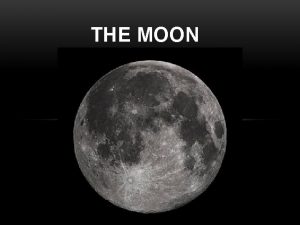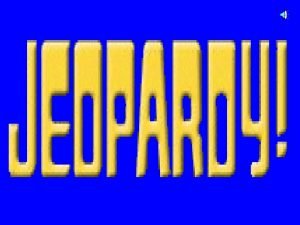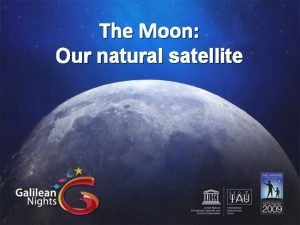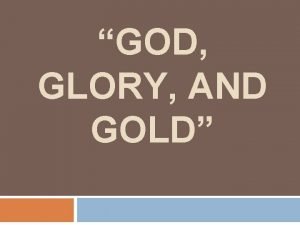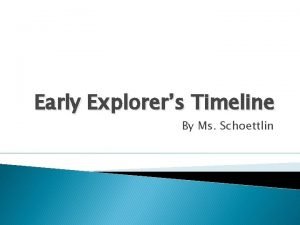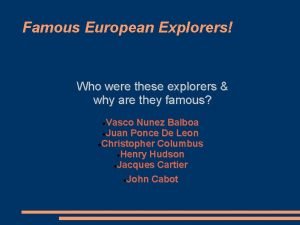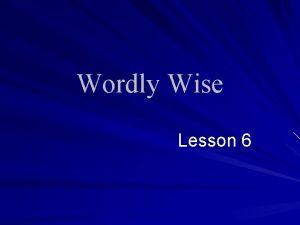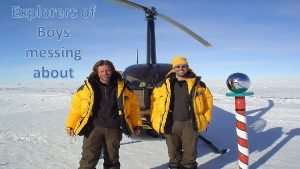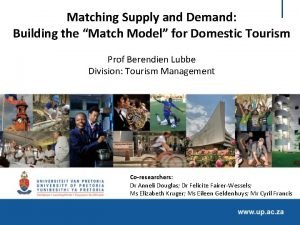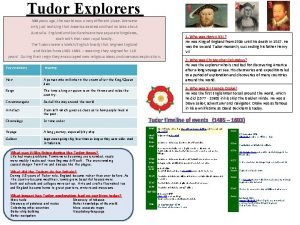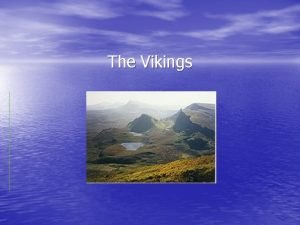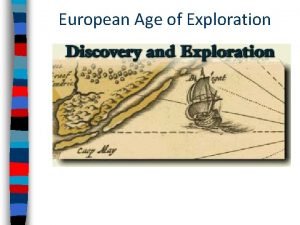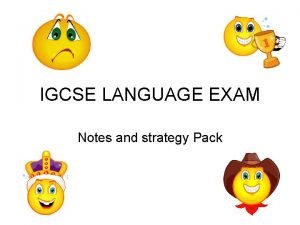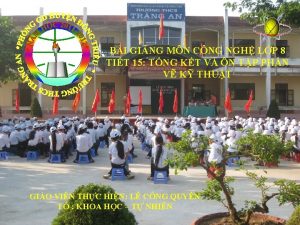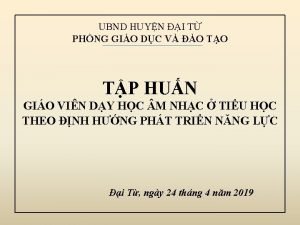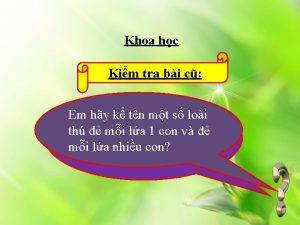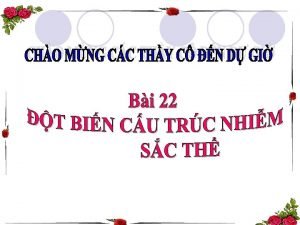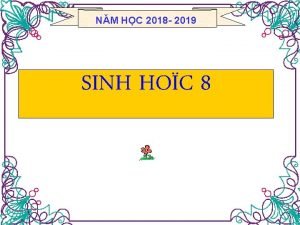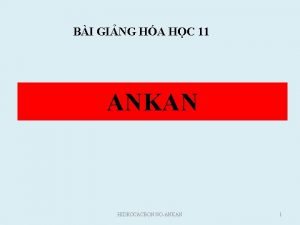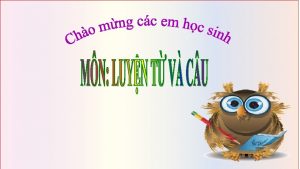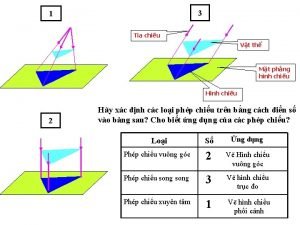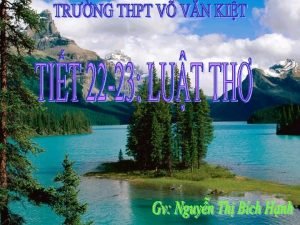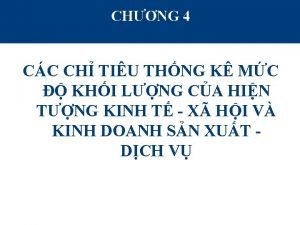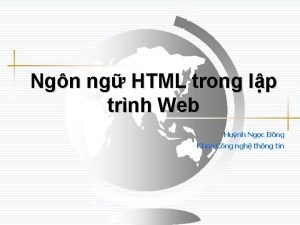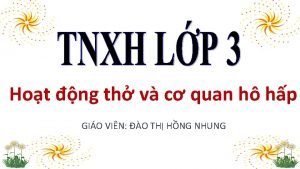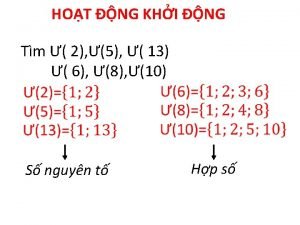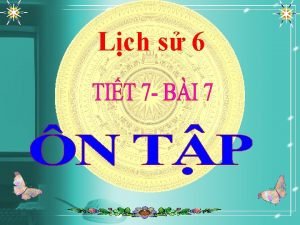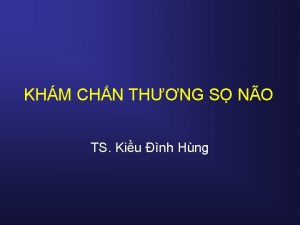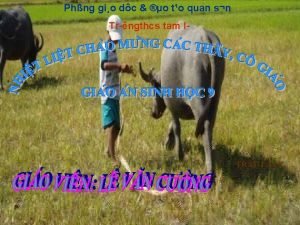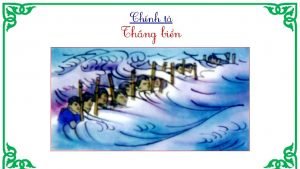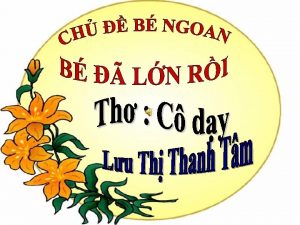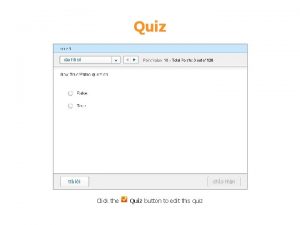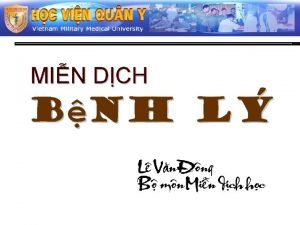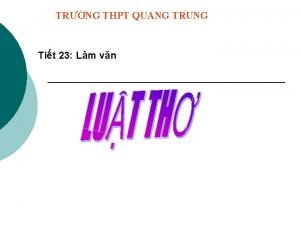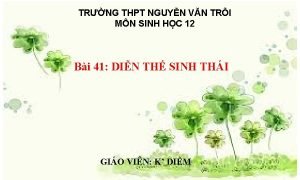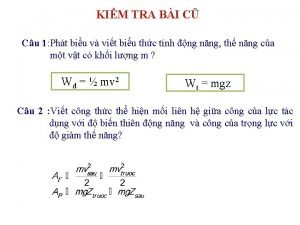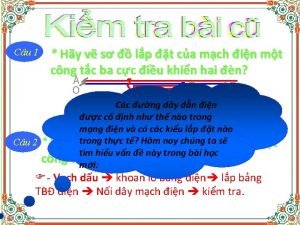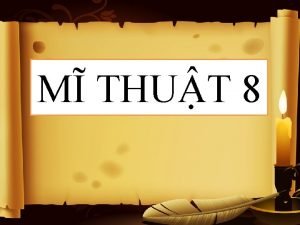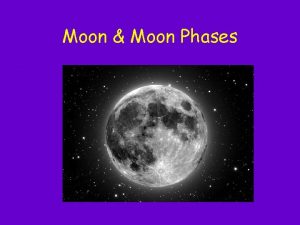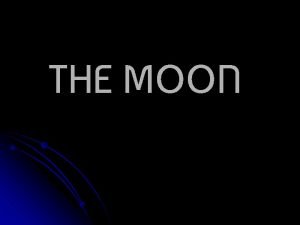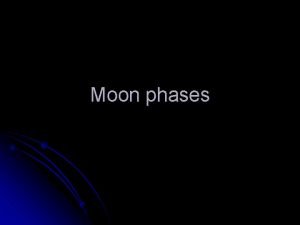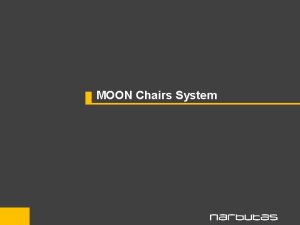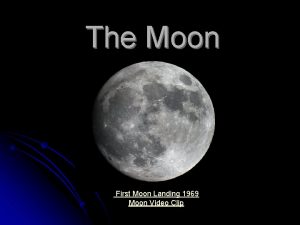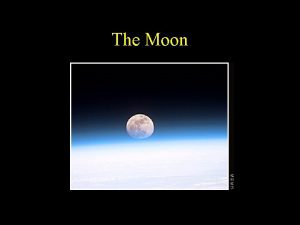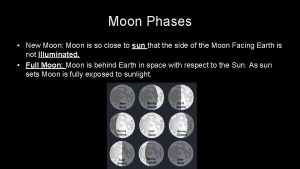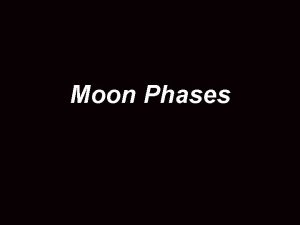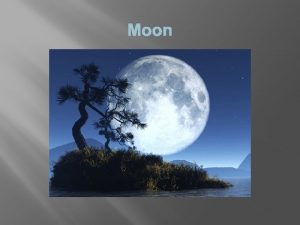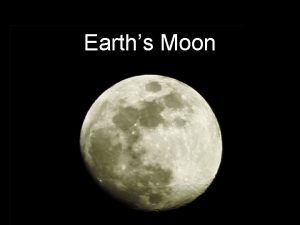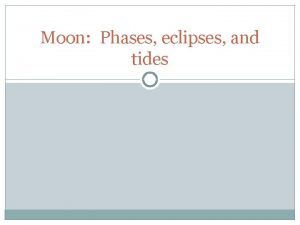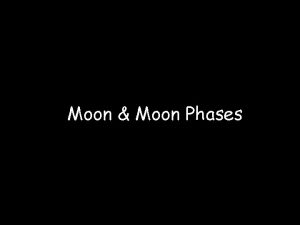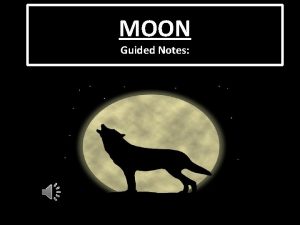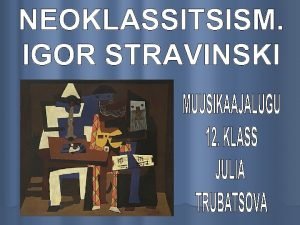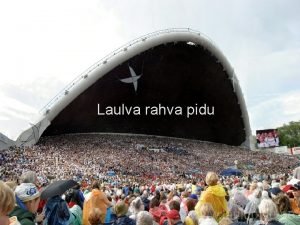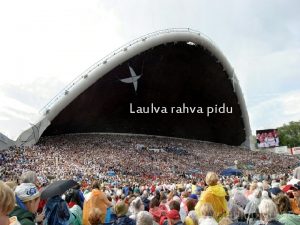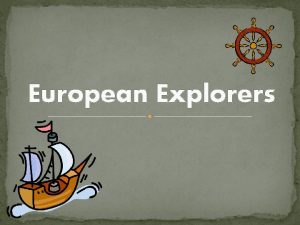Kuuuurija t jrel The moon explorers worknight on









![The goal of WALS Online • The goal of WALS is ‘[making] information on The goal of WALS Online • The goal of WALS is ‘[making] information on](https://slidetodoc.com/presentation_image_h2/860c805905502ae8d5fae40c218ef396/image-10.jpg)
















































- Slides: 58

"Kuu-uurija töö-öö jää-äärel" "The moon explorer's worknight on the edge of the ice".

Databases Session 2, April 24 th, 2009

Examples of typological databases • Databases of special projects, e. g. Northwest Iranian Project • Atlas of Pidgin and Creole Language Structures (APi. CS) • The World Atlas of Language Structures - WALS

ONLINE TYPOLOGICAL DATABASES • The Universals Archive (= what you can get out of databases) • http: //typo. uni-konstanz. de/archive/intro/ • Das grammatische Raritätenkabinett (= what you rarely find in databases) • http: //typo. uni-konstanz. de/rara/intro/ • The World Atlas of Language Structures Online • http: //wals. info/index • Language Typology Resource Center • http: //www. lotschool. nl/Research/ltrc/ • The Typological Database System Project • http: //languagelink. let. uu. nl/tds/index. html • http: //www. hum. uva. nl/TDS/

• • • Language Typology Database (Caen) http: //www. unicaen. fr/typo_langues/index. php? malang=gb Autotyp (Leipzig & Berkeley) http: //www. uni-leipzig. de/~autotyp/ Pavia Typological Database http: //www-1. unipv. it/paviatyp/ UPSID: UCLA Phonological Segment Inventory Database (by Ian Maddieson and Kristin Precoda) http: //www. linguistics. ucla. edu/faciliti/sales/software. htm http: //www. langmaker. com/upsidlanguages. htm http: //web. phonetik. uni-frankfurt. de/upsid (=Henning Reetz's. UPSID interface) Stress. Typ (Leiden) http: //stresstyp. leidenuniv. nl/

• • • XTone: Cross-Linguistic Tonal Database (Berkeley) http: //xtone. linguistics. berkeley. edu/index. php Metathesis Database (Ohio State) http: //www. ling. ohio-state. edu/~ehume/metathesis/ The World Color Survey (Berkeley) http: //www. icsi. berkeley. edu/wcs/ The Surrey Morphology Group: Databases http: //www. smg. surrey. ac. uk/ Graz Database on Reduplication http: //reduplication. uni-graz. at/redup/

• Matthew Dryer's Typological Database • http: //linguistics. buffalo. edu/people/faculty/dryer/da tabase • Plank, TYPOLOGY Reading List 64 • Intensifiers and Reflexives (FU Berlin) • http: //noam 2. anglistik. fu-berlin. de/~gast/tdir/ • Reciprocals (FU Berlin & Utrecht) • http: //languagelink. let. uu. nl/burs/ • Focus Quantifiers (FU Berlin & Antwerp) • http: //noam 2. anglistik. fu-berlin. de/~gast/fq/ • Numbers from 1 to 10 in over 5000 Languages • http: //www. zompist. com/numbers. shtml

What is WALS? • The World Atlas of Language Structures Online. Ed. by Martin Haspelmath, Matthew S. Dryer, David Gil & Bernard Comrie. Munich: Max Planck Digital Library. Available online at http: //wals. info/.

WALS • The World Atlas of Language Structures (2005) contains 142 maps of the distribution of phonological, grammatical and lexical phenomena in the languages in the world
![The goal of WALS Online The goal of WALS is making information on The goal of WALS Online • The goal of WALS is ‘[making] information on](https://slidetodoc.com/presentation_image_h2/860c805905502ae8d5fae40c218ef396/image-10.jpg)
The goal of WALS Online • The goal of WALS is ‘[making] information on the structural diversity of the world’s languages available to a large audience’

WALS Online. Characteristics • WALS Online is a website consisting of five main parts. The first part, Features, functions as an index to the 142 maps and chapters of the original edition. • The second part, Languages, provides multiple interfaces to the languages that comprise the WALS dataset. Languages are indexed by name, by language family, and by country.

WALS Online. Characteristics • The third major part of WALS Online is a database of all 5728 references for extracting the feature values for the individual languages. • The fourth part of WALS Online is simply an index of all the authors that coded features and wrote the chapter texts, with links to the features.

WALS Online. Characteristics • The fifth part of the site is called Newsblog. The link leads to messages in the category ‘News’ on a weblog that at the same time functions as a place where comments pertaining to individual Features/Chapters can be left. To that end, every feature page includes a link ‘discuss’ which leads to a post on the blog.

For the users of WALS Online • For usability and extensibility, there are the following facilities: • a downloadable KML file (containing the placemarks and feature values) is provided for each page that includes a map. • the same data is also available in XML format. • Every chapter contains a ‘cite’ link • Every chapter contains a link to a downloadable PDF version

Further issues • The reference database is fully searchable, and every single citation can also be exported to various formats. • For further data on the database, for its current challenges, how it can be used, and the question of genealogical data, see • http: //email. eva. mpg. de/~cysouw/pdf/cysouw. GRAZ. pdf • http: //email. eva. mpg. de/~cysouw/pdf/cysouw. CHALLENGES. pdf • http: //email. eva. mpg. de/~cysouw/pdf/cysouw. KOENIG. pdf

http: //wals. info • You will see the webpage of the WALS as I show it to you • On that page, you click and scroll further on your own!

Typology bibliography for reference Comrie, Bernard, Language universals and linguistic typology: syntax and morphology. Blackwell, Oxford, 1981. Croft, William. Typology and universals, second edition. (Cambridge Textbooks in Linguistics. ) Cambridge: Cambridge University Press, 2003. Dahl, Östen. The growth and maintenance of linguistic complexity. Studies in Language Companion Series. Amsterdam/Philadelphia: John Benjamins, 2004. Dahl, Östen. Tense and aspect systems. New York: Basil Blackwell, 1985. Martin Haspelmath, Matthew S. Dryer, David Gil, Bernard Comrie (Eds. ). The World Atlas of Language Structures. Oxford: Oxford University Press, 1995. Heine, Bernd and Kuteva, Tania. Language contact and grammatical change (Cambridge Approaches to Language Contact). Cambridge: Cambridge University Press, 2005. For an additional list of readings, see the following website: http: //en. wikipedia. org/wiki/Linguistic_typology

On the Uralic languages Daniel Abondolo (ed. ). 1988. The Uralic languages (Routledge Language Family Descriptions). London & New York: Routledge. (choose one chapter/language, ca. 25 pp. )

Internet links by Bernhard Wälchli Links to linguistic typology and some other (maybe) useful links ALT – Association for Linguistic Typology http: //www. lancs. ac. uk/fss/organisations/alt/ (membership directory, grammar watch) Many typologists have some of their publications on-line on their homepages. Some examples: Matthew Dryer http: //linguistics. buffalo. edu/people/faculty/dryer/dryer. htm Martin Haspelmath http: //email. eva. mpg. de/haspelmt/ Östen Dahl http: //www. ling. su. se/staff/oesten/index. htm Maria Koptjevskaja Tamm http: //www. ling. su. se/staff/tamm/ Michael Cysouw http: //email. eva. mpg. de/cysouw/ Balthasar Bickel http: //www. uni-leipzig. de/bickel/research/papers/index. html Stephen Levinson http: //www. mpi. nl/Members/Stephen. Levinson/Publications Nick Enfield http: //www. mpi. nl/Members/Nick. Enfield/Publications

…continued The Leipzig Glossing Rules http: //www. eva. mpg. de/lingua/files/morpheme. html The Universals Archive http: //ling. uni-konstanz. de: 591/Universals/introduction. html Das Grammatische Raritätenkabinett http: //ling. uni-konstanz. de: 591/universals/introrara. html Surrey Morphology Group homepage: http: //www. surrey. ac. uk/LIS/SMG/ (Under Construction): Linguipedia http: //lingweb. eva. mpg. de/confer/wiki/index. php/Main_Page Questionnaires http: //lingweb. eva. mpg. de/fieldtools/tools. htm#questionnaires The Ethnologue (An encyclopedic reference work cataloging all of the world’s 6, 912 known living languages) http: //www. ethnologue. com/ The Rosetta Project: Building an Archive of ALL documented human languages http: //www. rosettaproject. org/archive/ Dictionaries http: //www. yourdictionary. com/languages. html Max Planck Institute for Psycholinguistics in Nijmegen (with hopefully more of their stuff online in the future) http: //www. mpi. nl/ Library Hyper-Catalogue (Germany and some other countries) http: //www. ubka. uni-karlsruhe. de/kvk. html Book reviews: http: //linguistlist. org/pubs/reviews/browse-by-pub 1. html Used and out of print books: http: //used. addall. com/ For those who read Swedish: http: //www. ling. su. se/lingvistik/special/samlisar. html

Best short description on Estonian • http: //how-to-learn-anylanguage. com/forum_posts. asp? TID =12437&get=last

About the tree by Michael Cysouw • • • Based on the data of the WALS in April 2009 Using the program Splits. Tree -- a popular program for inferring phylogenetic trees or, more generally, phylogenetic networks from various types of data such as a sequence alignment, a distance matrix or a set of trees. According to its developers, Splits. Tree uses published methods such as split decomposition neighbor-net, consensus network, super networks methods or methods for computing hybridization or simple recombination networks. Source http: //en. wikipedia. org/wiki/Splits. Tree A phylogenetic tree or evolutionary tree is a tree showing the evolutionary relationships among various biological species or other entities that are believed to have a common ancestor. In a phylogenetic tree, each node with descendants represents the most recent common ancestor of the descendants, and the edge lengths in some trees correspond to time estimates. Each node is called a taxonomic unit. Internal nodes are generally called hypothetical taxonomic units (HTUs) as they cannot be directly observed. Source http: //en. wikipedia. org/wiki/Phylogenetic_tree

• Rokonszenv (Ny. TI) • http: //fu. nytud. hu/nyk. htm



http: //www. eki. ee/murded/fonoteek/ • http: //www. eki. ee/murded/fonoteek/index. p hp? leht=3&haldus=Liivi

• http: //kaino. kotus. fi/


http: //kaino. kotus. fi/cgibin/julk 1/termit. cgi

www. keeletehnoloogia. ee



http: //www. cl. ut. ee/korpused/kasuta jaliides/


http: //eelex. eki. ee/shslogin. htm


http: //www. keeleveeb. ee/

Filosoft freeware http: //www. filosoft. ee/ contains several useful language tools for Estonian


http: //www. eki. ee/ Many electronic dictionaries, language resources can be found at the website of the Institute of the Estonian Language: www. eki. ee Online reference grammar of Estonian: http: //www. eki. ee/books/ekk 07/

EKI resources • Some examples: http: //www. eki. ee/dict/ http: //www. eki. ee/corpus/ http: //www. eki. ee/knab/ http: //www. eki. ee/termin/ Linguistic software: http: //www. eki. ee/tarkvara/ Help in language: http: //www. eki. ee/keeleabi/ The corpus of emotional speech: http: //urve. eki. ee: 5000/ • Open for public: dictionaries of EELex: The official spelling and meanings, newer version: http: //www. eki. ee/dict/qs 2006/ The same dictionary, complex queries: http: //www. eki. ee/dict/QS 2006. tegemisel/full. html In autumn 2009, the Monolingual dictionary will be made public. The basis for Estonian-X dictionaries, public version: http: //exsa. eki. ee/

Keelevara Most electronic dictionaries can be found at http: //www. keelevara. ee/login/









Instructions for using the parser (Házi feladat) 1. Download the parser (author of this parser: Kaili Müürisep) from the following website: www. ut. ee/~kaili/nptool/Oktoober. zip 2. Having unpacked the parser, you need to start the program by clicking on the icon that is indicated with blue highlight on the follolwing slide. 3. Copy the text you need to analyze in the upper window and see the solution in the lower one. Don’t panic, it looks more complicated than it is!


Missugused on eestlased? $LA$ #### Missugused mis_sugune+d //_P_ inter rel pl nom #cap // **CLB @SUBJ @PRD on ole+0 //_V_ main indic pres ps 3 pl ps af #Fin. V #Intr // @+FMV eestlased eestlane+d //_S_ com pl nom // @SUBJ @PRD $? ? //_Z_ Int // $LL$ ####

Other linguistic corpora • http: //www. murre. ut. ee/vakkur/Gooti/pildid. htm • http: //www. murre. ut. ee/vakkur/Korpused/k orpused. htm • http: //www. murre. ut. ee/vakkur/Gooti/Origin aal/Kiri. jpg. htm



Homework • Go through the WALS maps we discussed in the previous session and the maps number 49, 65, 68, 77, 95, 112, 121, 122 • See what they contain and lack about Estonian and your language and DOCUMENT your findings in writing. • Look at the websites and answer the questions on my slides of the first session.

Summary • This talk introduced the World Atlas of Linguistic Structures • And briefly mentioned other linguistic databases, typological or not • Focused a bit more on Estonian language resources that are available on the internet
 Home.hiwaay.net/ krcool/astro/moon/moon tides/
Home.hiwaay.net/ krcool/astro/moon/moon tides/ The science duo
The science duo How many days for a moon cycle
How many days for a moon cycle Which moon phase occurs directly before a new moon
Which moon phase occurs directly before a new moon Moon sister moon calendar
Moon sister moon calendar God gold glory drawing
God gold glory drawing Early explorers timeline
Early explorers timeline Famous european explorers
Famous european explorers Explorers wordly wise
Explorers wordly wise Explorers or boys messing about
Explorers or boys messing about Spontaneous budget explorers
Spontaneous budget explorers Spontaneous budget explorers
Spontaneous budget explorers Age of exploration webquest
Age of exploration webquest Tudor explorers
Tudor explorers Scandinavian explorers
Scandinavian explorers Famous tudor explorers
Famous tudor explorers European explorers
European explorers Explorers or boys messing about analysis
Explorers or boys messing about analysis đại từ thay thế
đại từ thay thế Vẽ hình chiếu đứng bằng cạnh của vật thể
Vẽ hình chiếu đứng bằng cạnh của vật thể Quá trình desamine hóa có thể tạo ra
Quá trình desamine hóa có thể tạo ra Các môn thể thao bắt đầu bằng tiếng chạy
Các môn thể thao bắt đầu bằng tiếng chạy Hình ảnh bộ gõ cơ thể búng tay
Hình ảnh bộ gõ cơ thể búng tay Khi nào hổ con có thể sống độc lập
Khi nào hổ con có thể sống độc lập Dot
Dot Nguyên nhân của sự mỏi cơ sinh 8
Nguyên nhân của sự mỏi cơ sinh 8 Trời xanh đây là của chúng ta thể thơ
Trời xanh đây là của chúng ta thể thơ độ dài liên kết
độ dài liên kết Chó sói
Chó sói Thiếu nhi thế giới liên hoan
Thiếu nhi thế giới liên hoan điện thế nghỉ
điện thế nghỉ Tia chieu sa te
Tia chieu sa te Một số thể thơ truyền thống
Một số thể thơ truyền thống Thế nào là hệ số cao nhất
Thế nào là hệ số cao nhất Frameset trong html5
Frameset trong html5 Hệ hô hấp
Hệ hô hấp Các số nguyên tố
Các số nguyên tố đặc điểm cơ thể của người tối cổ
đặc điểm cơ thể của người tối cổ Các châu lục và đại dương trên thế giới
Các châu lục và đại dương trên thế giới Tư thế worm breton là gì
Tư thế worm breton là gì ưu thế lai là gì
ưu thế lai là gì Thẻ vin
Thẻ vin Tư thế ngồi viết
Tư thế ngồi viết Bàn tay mà dây bẩn
Bàn tay mà dây bẩn Mật thư tọa độ 5x5
Mật thư tọa độ 5x5 Các châu lục và đại dương trên thế giới
Các châu lục và đại dương trên thế giới Từ ngữ thể hiện lòng nhân hậu
Từ ngữ thể hiện lòng nhân hậu Bổ thể
Bổ thể Tư thế ngồi viết
Tư thế ngồi viết Thế nào là giọng cùng tên
Thế nào là giọng cùng tên Thơ thất ngôn tứ tuyệt đường luật
Thơ thất ngôn tứ tuyệt đường luật Hát lên người ơi
Hát lên người ơi Khi nào hổ con có thể sống độc lập
Khi nào hổ con có thể sống độc lập Diễn thế sinh thái là
Diễn thế sinh thái là Vẽ hình chiếu vuông góc của vật thể sau
Vẽ hình chiếu vuông góc của vật thể sau Làm thế nào để 102-1=99
Làm thế nào để 102-1=99 Công thức tính thế năng
Công thức tính thế năng Thế nào là mạng điện lắp đặt kiểu nổi
Thế nào là mạng điện lắp đặt kiểu nổi Tỉ lệ cơ thể trẻ em
Tỉ lệ cơ thể trẻ em


